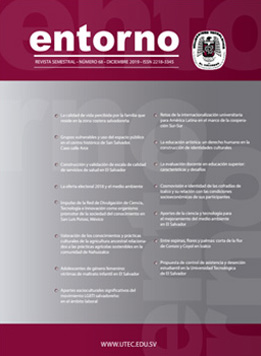Vulnerable groups and the use of public space in historic downtown San Salvador. The case of Calle Arce
Published 2019-12-30
Keywords
- Urban rehabilitation – Calle Arce – San Salvador, El Salvador,
- Urbanism – Calle Arce – San Salvador, El Salvador,
- Urban development – Calle Arce – San Salvador, El Salvador
Copyright (c) 2019 Entorno

This work is licensed under a Creative Commons Attribution-NonCommercial-ShareAlike 4.0 International License.
How to Cite
Abstract
This article summarizes the results of a qualitative research conducted on the use that people make of Calle Arce as part of the public space in the salvadorean capital city, especially by those ones who belong to vulnerable groups. The purpose is to synthesize the current situation by means of the analysis and conjunction of the gathered information, in the face of the recent projects, to physically intervene the city in order to contribute to the holistic understanding of the territory with the purpose of generating actions aimed at the re-appropriation of space in an integral manner. Field observations and interviews with people interested in collaborating were conducted. The final reflection is that Calle Arce, in spite of being a public space by definition, in practice—notwithstanding the municipal efforts-- is not an inclusive space because of the appropriation and constant struggle for space on that street.
Keywords: Urban rehabilitation - Calle Arce - San Salvador, El Salvador. Urbanism - Calle Arce - San Salvador, El Salvador. Urban development - Calle Arce - San Salvador, El Salvador.
URI: http://hdl.handle.net/11298/1123
DOI: https://doi.org/10.5377/entorno.v0i68.8443
References
- Elsalvador.com. (30 de junio del 016). Ventas informales vuelven a la calle Arce en el centro. Elsalvador.com. Recuperado de: https://historico.elsalvador.com/196903/ventas-informales-vuelven-a-la-calle-arce-en-el-centro.html
- Cortéz, M. (30 de junio 2016). Ventas informales vuelven a la calle Arce en el centro. Elsalvador.com. Recuperado de https://historico.elsalvador.com/historico/196903/ventas-informales-vuelven-a-la-calle-arce-en-el-centro.html
- García Canclini, N. (1996). Público-privado: La ciudad desdibujada. Alteridades, 6(11), 5-10. Recuperado de https://alteridades.izt.uam.mx/index.php/Alte/article/view/549/547
- Granillo, H. (2005). El rescate del espacio, una prioridad. En A. S. Menjívar de Síntigo (Com.), Centro histórico de San Salvador: Nuestro reto pendiente (p. 72). San Salvador. FUNDASAL. Recuperado de http://repo.fundasal.org.sv/195/1/CHSS_RETO%20PENDIENTE.pdf
- Gravano, A. (2016). Antropología de lo urbano. Santiago, Chile: LOM. https://books.google.com.sv/books?id=S5nuDQAAQBAJ&lpg=PP1&dq=Antropolog%C3%ADa%20de%20lo%20urbano&hl=es&pg=PP1#v=onepage&q=Antropolog%C3%ADa%20de%20lo%20urbano&f=false
- Hernández Aja, A. (julio-agosto, 2007). Áreas vulnerables en el centro de Madrid. Cuadernos de Investigación Urbanística, (53). Recuperado de http://polired.upm.es/index.php/ciur/article/view/268/263
- Hernández, J. M. y Díaz García, V. (2018). Visiones del hábitat en América Latina: Participación, autogestión, habitabilidad. Barcelona, España: Editorial Reverté.
- Hernández Sampiere, R., Fernández Collado, C. y Baptista Lucio, M. P. (2014). Metodología de la investigación (6ªed.) [versión de Adobe Acrobat Reader]. Recuperado de http://observatorio.epacartagena.gov.co/wp-content/uploads/2017/08/metodologia-de-la-investigacion-sexta-edicion.compressed.pdf
- Herodier, G. (1997). San Salvador: El esplendor de una ciudad 1880-1930. San Salvador, El Salvador: ASESUIZA.
- Martínez, D. (20 de abril del 2016). Alcaldía de San Salvador inicia recuperación del centro histórico. Diario Co Latino.
- Recuperado de https://www.diariocolatino.com/alcaldia-de-san-salvador-inicia-recuperacion-del-centro-historico/
- Muñoz Villalobos, D. y Catalán Neumann, R. (diciembre, 2015). Percepción urbana: Imagen de la ciudad de Talca según población adolescente. Revista electrónica de geografía austral, 7(2). Recuperado de http://revistanadir.yolasite.com/resources/PERCEPCI%C3%93N%20URBANA%20nadir%202015.pdf
- Naciones Unidas. (2017). Nueva agenda urbana [versión de Adobe Acrobat Reader]. Recuperado de http://habitat3.org/wp-content/uploads/NUA-Spanish.pdf
- Naciones Unidas. (2020). Objetivos de desarrollo sostenible. Recuperado de https://www.un.org/sustainabledevelopment/es/cities/
